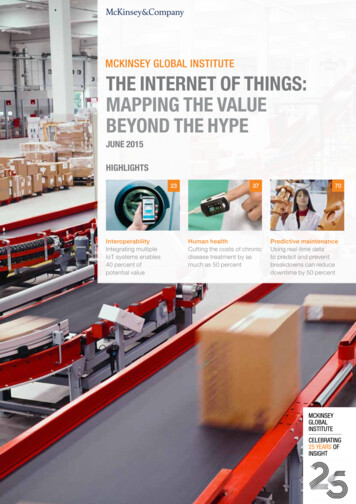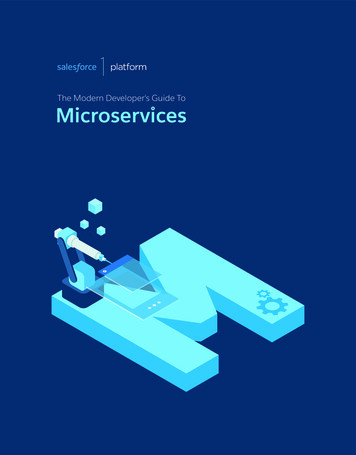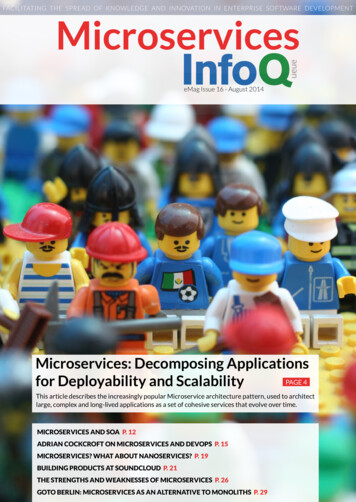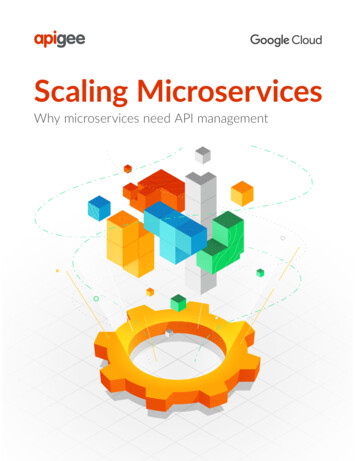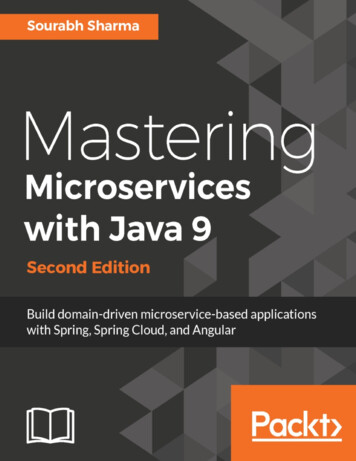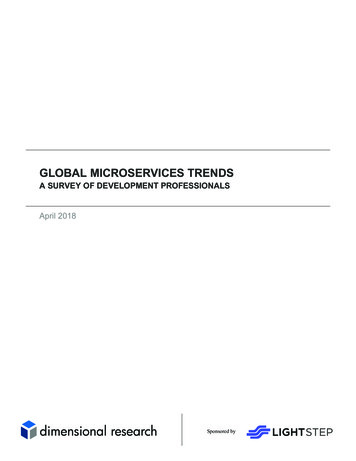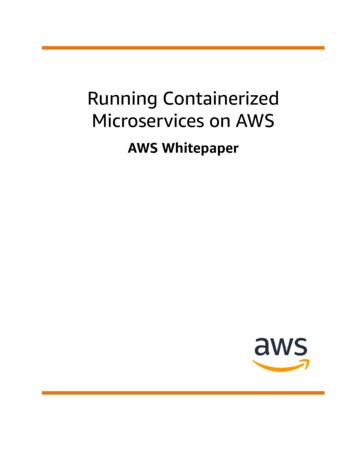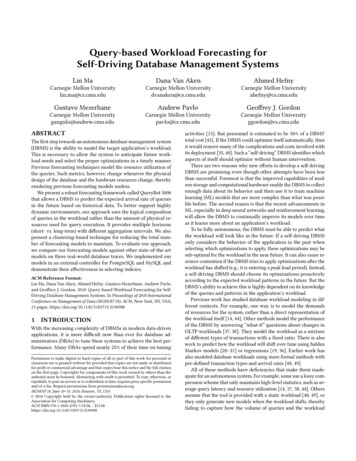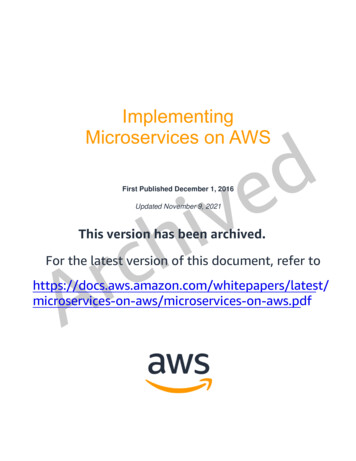
Transcription
Microservices Beyond the HypeSATURN – San DiegoMay 3, 2016Paulo Merson
Our goal Try to define microserviceDiscuss what you gain and what you lose withmicroservices2
Defining Microservice Unfortunately there’s no consensual definition But here’s a widely referenced attempt to define it:The microservice architectural style is an approach to developing asingle application as a suite of small services, each running in its ownprocess and communicating with lightweight mechanisms, often anHTTP resource API. These services are built around businesscapabilities and independently deployable by fully automateddeployment machinery. [Lewis 2014]3
But from whatI’ve seenout there,microservicesare morethan that4
Microservices: the hype and the bloatedfeatures Based on a web search, one might think microservices should: Have few lines of code (some say 10-100 LOC)Be developed by a team that can be fed by 1 or 2 pizzasOffer coarse-grained operations (though microservices are fine-grainedservices)Not participate in complex service compositionsBe monitored by sophisticated logging and monitoring infrastructureBe developed by teams split around business capabilities per Conway's lawBe run by the team who built themManage their own databasesMatch DDD bounded contextsBe dynamically discoveredBe small enough to be rewritten in two weeks5
If it’s not microservices, it is To understand the new weneed to look back to the old:The monolithic model6
The monolith All services within the application (or some equivalent boundary) arepackaged together into one deployment artifactThis deployment artifact or deployment bundle is the “monolith”Any small change to the applicationrequires building and redeployingthe entire monolithThis approach has been the normsince the beginning of multi-tierWeb applications and SOA7
The microservice The microservices style dictates that the deployment unit shouldcontain only one service or just a few cohesive services This deployment constraint is the distinguishing factor [Merson 2015a]microservices8
Monolithic and microservices - variationsServices deployed separatelybut still monolithicContainerized microservices9
Microservice design Though the style doesn’t mandate specific technologies,microservices typically communicate via: Microservices should be designed according to SOA designguidelines HTTP (following the REST style)Asynchronous messages/eventsDefining the functional context of a microservice is criticalMicroservice is not a good alternative in all cases As always the architect should weigh thetradeoffs against the requirements10
Microservices benefits* (1) Deployability More agility to roll out new versions of a service due to shorterbuild test deploy cyclesFlexibility to employ service-specific security, replication, persistence,and monitoring configurationsScalability Each microservice can be scaled independently using pools, clusters,and gridsThe deployment characteristics make microservices a great match forthe elasticity of the cloud* Source: Microservices Beyond the Hype: What You Gain and What You Lose [Merson 2015b]11
Microservices benefits (2) Modifiability More flexibility to use new frameworks, libraries, data sources, and otherresourcesMicroservices are loosely coupled, modular components accessible onlyvia their contractsDynamic discovery and binding via a registry is sometimes used forlocation transparencyAvailability Rolling out a new version of a microservice requires little downtime,whereas in the monolith it requires a slower restart of the entire monolith12
Microservices benefits (3) Management Design autonomy Application development effort is divided across teams that are smallerand work more independentlyThe team has freedom to employ different languages, frameworks, andpatterns to design and implement each microserviceThe team can redesign and redeploy each microservice independentlyReliability A fault affects that microservice alone and its consumers, whereas in themonolithic model a service fault may bring down the entire monolith13
Microservices challenges (1) Deployability Performance Deployment becomes more complex with many jobs, scripts, transferareas, and configuration files for deploymentServices more likely need to communicate over the network, whereasservices within the monolith may benefit from local (in-process) callsIf the microservice uses dynamic discovery, the registry lookup is aperformance overheadMemory use Several classes and libraries are often replicated in each microservicebundle, and the overall memory footprint increases14
Microservices challenges (2) Modifiability Mechanisms to improve autonomy, such as eventual consistency andasynchronous calls, add design complexity to microservicesChanges to the contract more likely impact consumers deployedelsewhere Testability In the monolithic model, consumers are more likely to be within the monolithand will be rolled out in lockstep with the serviceAutomated tests are harder to set up and run because they may spandifferent microservices on different runtime environmentsManagement The application operation effort increases because there are moredeployed components, log files, and connections to oversee15
Microservices challenges (3) Availability If you use a registry for dynamic discovery, unavailability of the registrymay compromise the consumer-service interactionRuntime autonomy In the monolith, the overall business logic is collocated, whereas withmicroservices the logic is spread across microservices All else being equal, a microservice is more likely to interact with othermicroservices over the network—that interaction decreases autonomyIf the interaction between microservices involves changing data, theneed for a transactional boundary further compromises autonomy16
How to avoid autonomy issues? There are different techniques to avoid runtime autonomy issueswith microservices: Data replication plus eventual consistencyEvent-driven architecture (EDA)Command query responsibility segregation (CQRS)Aligning microservices with DDD bounded contextsThese techniques are not inherent to microservicesThey can prevent autonomy issues that could arise from splittingservices in a monolith into microservices17
For more information[Fowler]Fowler, M. “Microservice Trade-Offs”. 2015. Available ade-offs.html[Lewis 2014]Lewis, J.; & Fowler, M. “Microservices”. 2014. Available tml[Merson 2015a]Merson, P. “Defining Microservices.” SATURN blog, 2015. Available ning-microservices.html[Merson 2015b]Merson, P. “Microservices Beyond the Hype: What You Gain and WhatYou Lose.” SATURN blog, 2015. Available u-lose.html[Merson 2016]P. Merson. ”Microservice design pattern”. SOAPatterns.org, April 2016.Available at: http://soapatterns.org/design patterns/microservices[Newman 2015]Newman, S. Building Microservices. O’Reilly Media, 2015.[Richardson 2015]Richardson, C. “Pattern: Microservices Architecture”. Available html18
Questions – now or laterPaulo Mersonpmerson@acm.org19
BACKUP SLIDES20
Microservice FAQ (1)1.Is microservice an architecture style/pattern? 2.What is MSA? 3.It’s microservices architecture, but the acronym didn’t stick.Can I use SOAP in microservices? 4.Yes, and it has been described as such [Richardson 2015,Merson 2016].In general, tools, frameworks, and literature around microservicesconsider http (REST) and event-driven messaging as the options,not SOAP.Can I use platform specific component technologies inmicroservices? Same as previous answer.21
Microservice FAQ (2)5.Are microservices “SOA done right”? 6.Do I need an API gateway to use microservices? 7.No, the API gateway is optional.Can I use an API gateway if I am not doingmicroservices? 8.No. First off, microservice is not the right solution in all cases.Second, many people were not successful with SOA but now weknow how “to do it right”—ask me how.Yes, it’s useful if you have public REST-based APIs regardless ofwhether they follow the microservice style.What’s an API gateway? See next slide.22
API gateway (1) API gateway has recently been added to the SOA landscape An API gateway is middleware that intercepts all calls to yourpublicly visible services This kind of product emerged from the increasing prominence of APIs asa means of doing business with an organizationAPI gateway is an example of API management softwareThus it centralizes access to your APIsThese APIs are basically REST servicesAPI gateways also offer several features, many of them found inESBs, such as Message transformation and protocol bridgingMessage routingTraffic monitoring23
API gateway (2)The API gatewayproxies all callsfrom diverse clientapps to your publicAPIs24
microservices the logic is spread across microservices All else being equal, a microservice is more likely to interact with other microservices over the network—that interaction decreases autonomy If the interaction between microservices involves changing data, the need for a transactional boundary further compromises autonomy 16


